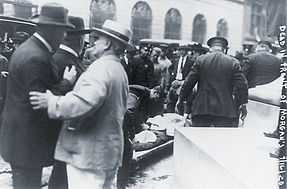Mario Buda
| Mario Buda | |
|---|---|
 | |
| Born |
October 13, 1884 Savignano sul Rubicone, Italy |
| Died |
June 1, 1963 (aged 78) Savignano sul Rubicone, Italy |
| Nationality | Italian |
| Known for | Bomb Creation (Wall Street bombing) |
Mario Buda (13 October 1884 - 1 June 1963) was an Italian anarchist, active in the United States from 1917 to 1920.[1] He was a Galleanist, and an Propaganda of the deed anarchist. He is best known as the perpetrator of the Wall Street Bombing, which killed 30 people immediately, and another eight died later of wounds sustained in the blast. There were 143 seriously injured, and the number of injured was in the hundreds.[2]
Early life and career
Buda was born in the city of Savignano sul Rubicone, in the region of Romagna that at the time was a center of anarchism and it is very possible that he became an anarchist in the beginning of his teenage years. He was a restless young man, and at fifteen years of age he was arrested for robbery and then later, faced a conviction for noise pollution in the night.[3] After he was discharged from jail, he began work as an apprentice shoemaker, but finding no economic stability, he decided to emigrate to the United States in 1907. There he was hired to work as a gardener, mason, worker in a telephone company as well as a hat factory, and many other menial jobs. In America he spent many long periods of terrible economic hardship , so in 1911 he decided to return to Italy. Two years later he returned to the United States , settling in Boston (Massachusetts) , where he worked as a laborer in the footwear industry.[4]
Life in the United States, and Sacco and Vanzetti meeting
Buda, met Nicola Sacco during the strike of 1913 in Hopedale, and three years later, he met Bartolomeo Vanzetti in Plymouth.[5] He began to attend the anarchist group of these two Italian-Americans who were followers of Luigi Galleani,and also devoted his free time to the organization of tree Italian anarchist schools of thought, where Italian immigrants are taught the rudiments of anarchism.[6] In 1916 he was arrested in Boston, for taking part in a demonstration against the US intervention in the World War I. During the proceedings against him, he refused to take the oath on the Bible, and was sentenced to five months in prison. In 1917, to escape the call of the army after the US entry into the war , he went with Sacco and Vanzetti and others to Monterrey (Mexico),which at this time had a vibrant community of Italian anarchists. During this time, Buda made a living as a laborer in a laundry room sharing his salary with the other members of the community.[7]
Terrorist activities
In 1917 Buda met with ten other anarchists (including his friend Carlo Valdinoci) to attack the police station in Milwaukee (24 November) which caused the death of 10 policemen and 1 civilian.[8] This action was in retaliation for the killing of two anarchists during the anti-military rally held in Milwaukee September 9, 1917.[9] The authorities, however, were never be able to prove the guilt of the accused, because many of them were in prison at time of the bombing. As a response to the repression, anarchist bombings followed across the country (June 2, 1919 bombs explode in Paterson, New Jersey, Boston, Philadelphia, Cleveland, Pittsburgh and Washington, D.C.), although most did not not create serious consequences.[10] In this climate, the New Immigration Act was promulgated on October 16, 1918, by which foreigners could be expelled who were involved or simply accused of subversive activities. Many anarchists were repatriated to their country of origin because of this law.[11]
Wall Street bombing
In September 11, 1920 the anarchists Sacco and Vanzetti, Buda's friends and companions, were charged with robbery and murder in South Braintree, and the climate,already simmering from the promulgation of anti-anarchist laws and the deportation of Luigi Galleani, literally got over-heated. Five days later, on September 16, a man traveled to Wall Street with a horse drawn cart, and stopped between the headquarters of the J.P.Morgan Bank and the Stock exchange. At noon the cart, loaded with 100 pounds of dynamite and 500 pounds of cast-iron sash weights, exploded through a remote control device. The bank and other buildings were severely damaged but remained intact. 38 people died and another two hundred were injured. The US authorities responded promptly. The investigation was headed by William J. Flynn, director between 1919 and 1921 of the of Bureau of Investigation, the forerunner of the Federal Bureau of Investigation. About Flynn, Attorney General Palmer said, "Flynn is a hunter of anarchists ... the greatest expert in anarchist circles of the United States". Flynn claimed that the attack was a response to the arrest of Sacco and Vanzetti. Flynn immediately began to track the anarchists and showed particular interest in the followers of Luigi Galleani's related Subversive Chronicle newspaper. In particular, attention was turning to Mario Buda, based on the testimony of a blacksmith who had rented the horse which was used to pull the explosive wagon. Buda, however, was able to avoid detection and left New York to embark on a trip back to his old home in Italy.[12]

Activity in Italy
After some time back in Italy, Buda was arrested in Savignano, being charged with having participated in the clashes between fascists and Anti-fascists on 28 February 1921, during which he had supposedly killed a police sergeant. Accused along with 15 other people, all were acquitted due to lack of evidence. On 10 August 1922, during a search of his home, police found numerous letters, which he had received from American anarchists with whom he had kept in touch, including a letter of Nicola Sacco. Between 1925 and 1927 he commuted to Rimini , where he found work as a shoemaker . Buda made no secret of his friendship with Sacco and Vanzetti who in the meantime had been sentenced to death . Three days before the execution of Sacco and Vanzetti on August 23, 1927, Buda was arrested and later sentenced to five years of confinement to be served in the island of Lipari, where he again met Luigi Galleani as well as Umberto Tommasini.[13] In 1932 he was moved to Ponza and a little later he was set free. He moved for two months to Switzerland, after which he returned to his home in Savignano. The Communist newspaper of France, claimed that Mario Buda was a espionage agent of Benito Mussolini's secret police and that he had come to France to betray other anarchists to the authorities. This was never proven because after his return to Savignano, he never left, and continued his trade working in the production and sale of shoes.
Death
In 1955, Mario Buda allegedly admitted to his nephew that he had built and detonated the Wall Street bomb. He had even remained at the scene after the explosion, but was neither interviewed nor arrested. He fled to his native Italy, where he remained under the pseudonym Mike Boda until his death. He was never brought to trial for his admitted crimes, which also included the detonation of a bomb in Milwaukee which killed 9 police officers in 1917. The Wall Street bombing case was never officially closed.[14]
References
- ↑ http://www.memoteca.it/upload/dl/E-Book/Mario_Buda.pdf
- ↑ After 1920 Blast, The Opposite Of 'Never Forget'; No Memorials on Wall St. For Attack That Killed 30
- ↑ http://italies.revues.org/2048
- ↑ The Sacco & Vanzetti Trial: Key Figures
- ↑ Nicola Sacco in Milford and Hopedale
- ↑ Mario Buda(aka Mike Buda)
- ↑ Sacco and Vanzetti: The Anarchist Background
- ↑ End of Watch: Saturday, November 24, 1917
- ↑ Anarchist Century - Recollection Used Books
- ↑ FBI-1919-bombings
- ↑ 263 U.S. 149 - Resource.Org
- ↑ The 1920 Wall St bombing: A terrorist attack on New York
- ↑ An Italian in America, Mario Buda
- ↑ Anarchists in America: The Wall Street Bombing of 1920
